“When I took over security there were no measures for MPs. There was so little for us. We didn’t matter. I hope that people will recognise what I have done, and stood up, and made sure that we can feel safe.” So began Lindsay Hoyle’s Speakership of the British House of Commons. Hoyle came to the role at the tail-end of the constitutional crisis over Brexit – which had its symbol in the fractious and imperial Speakership of John Bercow, his predecessor. Here was Bercow’s big idea: to conflate the administrative procedures of the House of Commons with the ‘rule of law’. In this way, an inflated Speakership and its parliamentary allies were able to hold the body in stasis for two years – unable to move legislatively, and unable to dissolve itself. By late 2019, this wrangling had failed. If the parliamentary opposition to Brexit had wanted to continue the fight, then it could have elected Chris Bryant, who offered to carry on with Bercow’s bumptious style. It did not.
Hoyle’s rise to the Speakership, then, was an aesthetic choice, not a political one. It was an acknowledgement of defeat and exhaustion. Hoyle, who had served as Bercow’s deputy, was far more circumscribed both personally and politically. With the arrival of a Brexit parliamentary supermajority, Hoyle promised to return the office to its traditional role: clerkship, not power. Hoyle the man had a number of appealing characteristics. He was old. His voice – endearingly – would haltingly stop, start, and loll from side to side. He was quaintly old-fashioned: the ‘at home’ photoshoots, of which there were many, revealed a riot of quilted couches, doily flaps, and floral carpets. Significantly, he was Northern – almost parodically so. The ‘Left Behind’ of the North would deliver Boris-Cummings its majority; Hoyle would be the ‘Left Behind’ Speaker, their spiritual representative.
Every Speaker has an official portrait made, and Hoyle’s appeared last month. We may have expected something in line with his own pipe-and-slippers style; something akin to the portrait of Neil and Glenys Kinnock in which both are sat comfortably in their kitchen, surrounded by an assortment of staring knick-knacks.
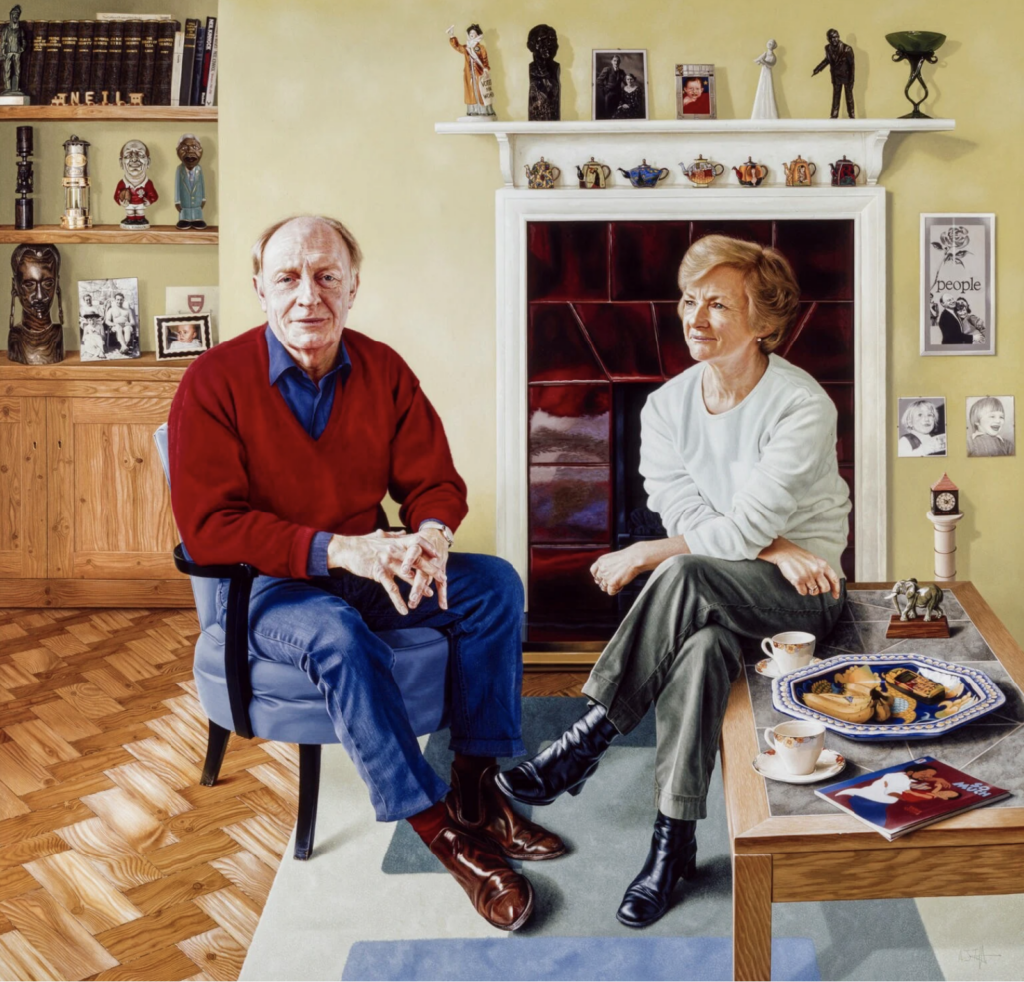
Little could prepare us for what was instead unveiled. The portrait, the handiwork of Australian artist Ralph Heimans, slams you in the face. It has a dull, throbbing intensity. It is painted in the realist style, but there’s nothing natural about it. It’s more real than real: the metal looks more like metal than metal; Hoyle looks more human than a human. No one feature pops out; every detail is accented and accented again, keyed up to its absolute limit and often well beyond it. There is nothing for the eye to rest on. It is matte, dense, and headache-inducing. It is insane. This is the painterly maximalism of a chocolate box, stretched across an entire canvas.
But it would be lazy and wrong to dismiss this as kitsch – though it certainly is. The portrait owes a certain debt to Norman Rockwell, maybe. But that isn’t the whole story. The glazed mania of this picture moves well past mere schmaltz.
For one, there’s the treatment of its subject. Hoyle’s Northern jollity is gone. This is someone in his full swagger, at the height of his secular powers. This Hoyle is a man of action and policy, and knows it. Our first comparison surely isn’t Rockwell, but royal portraiture – in particular, Hans Holbein the Elder’s lost rendering of Henry VIII. But even Henry disarms himself a little for us. In his arched eyebrows, in his small half-smile, we see something playful and self-aware about his own brittle arrogance.
Scan the images of other powerful people from past ages, and you’ll find the same candour and intimacy. Subjects were relaxed about letting themselves be depicted in less than heroic terms. The famous plea to be portrayed ‘warts and all’ was the rule, not the exception. Look at John Hoppner’s 1805 portrait of Pitt the Younger – then also at the height of his powers. We’re able to catch this famously bloodless man at an unguarded moment, lost in thought, and a little bored.
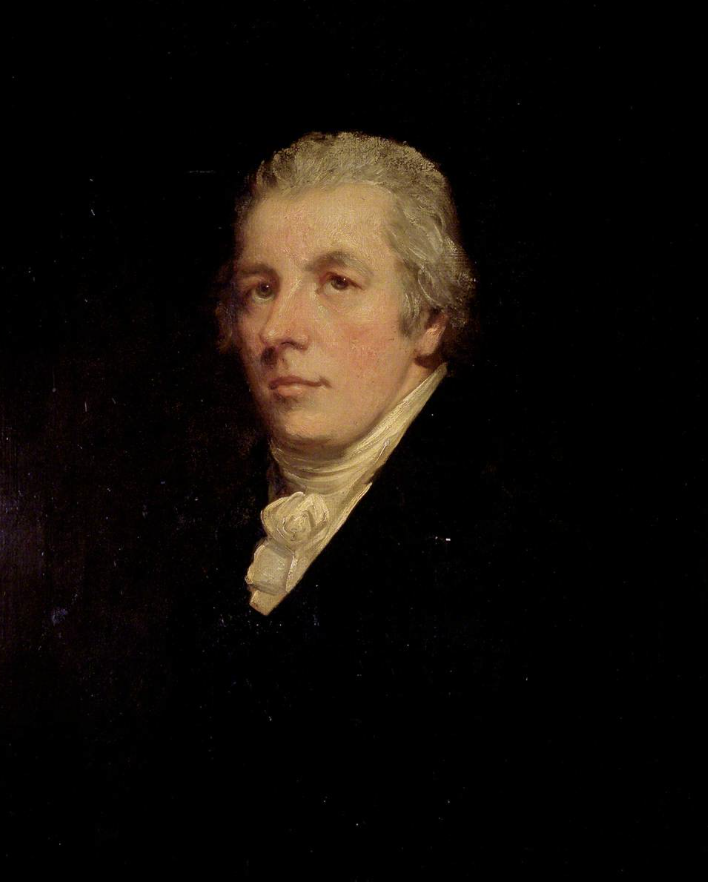
Here we see a post-war Herbert Asquith, baffled and beaten, slumped over a writing desk. Two more end-of-career depictions, one a bust of Harold Macmillan, another a portrait of Harold Wilson, take this method a little further. The expressionist smears and dribbles seem to deconstruct the two, but never take them apart entirely. They remind us that they are merely people; their existence, even as grandees of national life, is as contingent and ephemeral as everyone else’s. Merely people, but, above all, people to be reckoned with, people whose faces have been lined by lives of excitement, intrigue, and the cares of command. These depictions are unsparing, and tender.
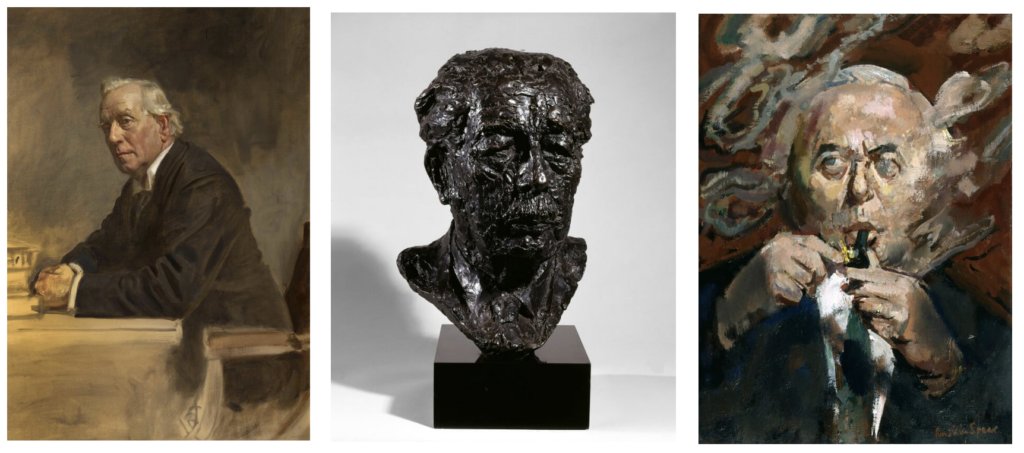
Heiman’s Hoyle does not let us in in this way. His expression is one of dead-eyed self-assurance. His smile reveals nothing, and yields nothing.
Why doesn’t it? This is a portrayal of one of the most visible fixtures of Britain’s governing class, a class that – as Hoyle’s earlier quote shows – sees itself as very much under siege. This is not a picture that can afford to be subtle, or playful. Authority is attacked everywhere, and cannot let its guard down. Artistic taste has changed to match. British art is now tasked with asserting the grandeur of the country’s reigning social order, against enemies both foreign and domestic.
This can explain Hoyle’s otherworldly stare. Authority has become deathly serious, and cannot present itself as wan, ironic, self-effacing, or vulnerable in any way. In this effort, Hoyle – as ever – does his duty. He fixes his eyes on the viewer, piercingly. It is an expression of reassurance, but also of command. Underlined here, too, is the enlarged power of the Speakership of the House of Commons. The defence of the current social order, which values procedure above all else, requires the destruction of the elected politicians, who alone have the power to change these procedures. The Brexit supermajority elected in 2019 has not been willing to break with this basic idea, especially after the resignation of Boris Johnson. As such, it never broke up the imperial Speakership established by John Bercow. Speaker Hoyle has inherited these powers, undiminished. Hoyle took up the role with a promise to reduce its influence. But he has not been able to resist the spirit of the age, which loves nothing more than a strivingly modest defender of procedure. The frivolous expulsions, the arraignments, the solemn speeches – these have all started to creep back in, as have the old Bercowite shrieks from the chair. “In this house, I’m in charge!” Hoyle bellows down to Boris Johnson. Hoyle’s commanding aspect, then, declares that the Bercow experience will not just be an aberration. It announces the arrival of the Speakership as a permanent and powerful factor in national life.
What also distinguishes this portrait from Rockwellian kitsch is its use of light. Everything in the picture emits a ruddy, radioactive glow: the walls, the windows, the tiles, Hoyle himself. According to Heimans, this is his own homage to chiaroscuro, a technique in which strong contrasts of dark and light are used to suggest volume, and to isolate a subject from its surroundings. But Hoyle is anything but isolated. He doesn’t stand out from the background at all. Everything lies flat on the same plane; the effect is to make Hoyle seem inextricable from his surroundings.
This is only fitting. In the post-Bercow era it is increasingly common to treat parliament not as a sovereign body, but as ‘The House’: a bundle of custom, tradition, procedure, and permanent staff. And now run, apparently, with quasi-judicial methods: as we have seen, it is now possible for an MP to commit statutory offences against The House. The fact that the Palace itself is falling to bits only increases its appeal. The increasing prominence of Westminster staff, and the welfare of MPs, makes this shift clear. This is no longer a body, but a place. It is a place superintended by an extended cast of lovable sprites: Blackrod; Clerks of the Commons in faded formal dress; Larry the Cat. Each are the keepers of this twisted Gormenghast and its lore, and are ready to see off any unwelcome intruders. Hoyle – and the Speakership in general – has become one with the Palace of Westminster, which is no longer the mere host to a democratic assembly, but a force unto itself.
Glance at the portrait of Michael Martin, another of Hoyle’s predecessors, and you’ll instantly cotton onto this change. He’s standing in the Commons chamber itself. The place looks palpably bigger than him. This is the point. Speaker Martin was a minor official, tasked with the day-to-day management of something larger than himself: a sovereign democratic authority. In the end, the task was beyond him, and he resigned in some disgrace. But he never pretended to be the master of the place, or the people who were elected to sit there. We find no attempt at usurpation in this picture.
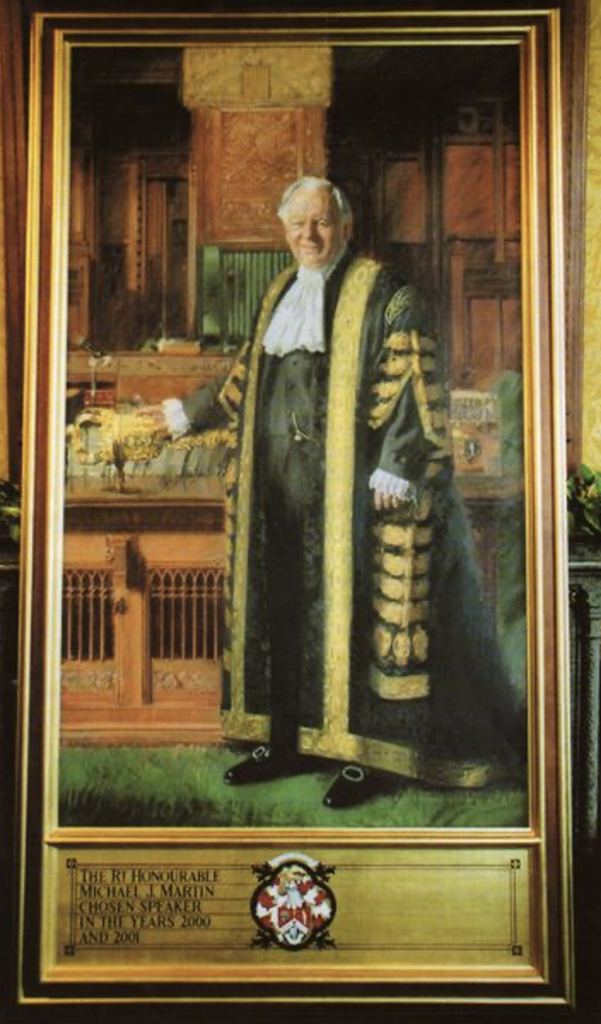
The Hoyle portrait underlines all these changes political and sentimental. In the 2020s, Britain’s ruling classes feel under attack. They cling in trembling to ritual and procedure, the last defence against the populist challenge. This is an apologia that lends itself to saccharine and schmaltz, and Britain’s artists have responded. Some have dubbed this new sentimental style ‘Carolean kitsch’, or ‘Stakeholder Realism’. Hoyle’s portrait is its first great artistic statement. It is the house style of a social order under attack; a social order which can only portray itself with hysterical earnest.
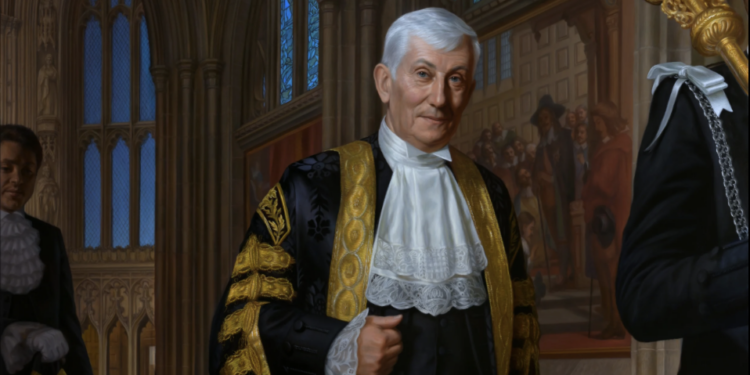













To join in with the discussion please make a donation to The Daily Sceptic.
Profanity and abuse will be removed and may lead to a permanent ban.
An astonishing article!
Is the author unaware that our new government is utilising the very latest in management techniques: ‘Mission Oriented Management’.
Me neither.
Here’s a handy guide:
https://www.forbes.com/sites/brettsteenbarger/2015/07/19/mission-based-management-the-leadership-of-purpose/
They are going to end sticking plaster politics:
https://labour.org.uk/wp-content/uploads/2023/02/5-Missions-for-a-Better-Britain.pdf
Great! I mean, what could possibly go wrong?
It’s easy. Look:
https://labour.org.uk/change/mission-driven-government/
‘We trained hard—but it seemed that every time we were beginning to form up into teams we were reorganized. I was to learn later in life that we tend to meet any new situation by reorganizing, and what a wonderful method it can be for creating the illusion of progress while actually producing confusion, inefficiency, and demoralization.’
(Apparently some disgruntled soldier of a literary bent, whether commissioned or noncommissioned I do not know, pinned this ‘quotation” to a bulletin board in one of the camps of the armies occupying Germany sometime after 1945 (the style suggests a British occupying force). Since the sentiment is impeccable, whether applied to military, governmental, or academic administration, it has enjoyed a cachet borrowed from Petronius (60 AD) ever since.)
In different words: ‘We are comprehensively fecked!’
Also attributed to a Roman soldier. So probably one of those things that has been a truism from time immemorial
I look at this Parliament as the second innings of brown and Blair, even if they are only in the background. Starmer is a puppet and his legal background means he is only capable of taking instructions. No moral integrity.
Look at those beady eyes. Him and that cretin Miliband can hardly believe their luck that the Tories turned into Labour lite and threw away an 80 set majority. They are rubbing their hands with glee. Miliband cannot wait to rip out your gas central heating
The Tories did not throw away an 80 seat majority, they engaged in controlled destruction as they had been ordered to.
As mentioned in the book by Nadine Dorries.
Interesting theory. ——–I won’t disagree with you, but maybe I would put it differently. I have no evidence for “controlled destruction”.—– I have always been of the opinion the extraordinary claims need extraordinary evidence and I do not have any for “controlled destruction”, but ofcourse it depends how you choose to define that. ——-I certainly think the Political Class are up to no good and are selling us out to globalists.
Actually upon further consideration “controlled destruction” is probably a good term for all of the things that are going on.
Nails it.
You couldn’t make it up, but they did.
GB News is showing all the new parasites moving into 10 Downing Street. Parris 1940 comes to mind.
Yep, the front bench is looking very, what’s the word…? ‘Diverse’. And here’s the new Justice Secretary;
https://x.com/DaveAtherton20/status/1809517291656101951
Sweet Jesus!
That’s a cracking start. Well at least the nations of the world know which side we are on. That’s what I would call nailing your colours to the mast.
Excellent article. Could not agree more about the competence and excellence crisis we are in. Mediocrity abounds, and many young people seem to think that trying hard is good enough. They are Minnows compared to the generations of the 1900s to 1960s.
A good theory that the left are mostly incompetent, university mis-educated, 2:1 achieving, fools, who have a high regard for their rather poor intellect.
Shades of Kamala Harris in that Mission Statement.
I would rather have the Raving Monster Loonies than this rabble of squirming eco fundamentalist mass immigration parasites.
Is it not also that English is being replaced by a sort of pidgin language, enshittified English?
Good point.
I have always regarded the deplorable use of written English as the fault of a failing education system. I think I am only partly correct. If this country is to be dismantled, and it is, then it makes sense that our beautiful language must also be dismantled.
English as a language that we love is to be bastardised and turned into some crude, lowest common denominator amalgamation of ghetto gutturals. How often on here do we remind ourselves of the need to protect the language?
Innit?
True dat, Blud!
Fanks for that Bruvva.
And yet another incompetent. Valance apponted Science Minister! I am just waiting for Neil Fergusson to be put in charge of implementing IT in the NHS.
Our computer models predict that half a million people will die in the UK over the next 12 months.
Panic!
On a serious note I do believe excess deaths will rage ever upwards under this Government and not just as a result of the injections. If misery and despair take hold as I fear they will our mortality rate must increase. Increasing living costs, loss of freedoms, hunger and cold will inevitably take a toll.
“people of the profoundest mediocrity.”
To describe any Labour people as “people of the profoundest mediocrity” is decidedly a gross exaggeration of their abilities.
Delusions of adequacy.
Aspiring to mediocrity?
I am amused that today the BBC weather presenter said that “temperatures this week will be lower than average”. This is an ideal example of the above, in that temperatures above average are “climate change” and ones lower are below “average”. The lack of mathematical understanding of the word average is astounding, instant knowledge-less mediocracy!
If we want a new Britain we need to end the welfare state and redistribution of wealth (Ha!) via the tax system as we are become a Nation of parasites each demanding to live off the other.
Back to property rights, autonomy, self-reliance, self-responsibility, self-sufficiency.
… while each western government is expecting to import Energy from its neighbour when the Wind doesn’t blow and the Sun doesn’t shine?
Good article. Although I disagree with the premise that malevolence and stupidity are mutually exclusive. I think what we’re observing culturally is because the exact opposite is true – they are joined at the hip.
New Britain is an island in Papua New Guinea. Perhaps this document indicates that the UK is to be refashioned into its lookalike.
Papua has over 800 known languages. Which must make the London Borough of Tower Hamlets look very non-vibrant. The regions of the UK are perhaps to become like the viable units of Papuan communities. The palm trees are already there in Torquay and Eastbourne.
Well those PCR tests are a bit like the initiation rites carried out there.
Is the country house like Miss Haversham’s? A coal from the fire slips out of the grate.
Unfortunately, though large sections of HS2 were cancelled, it left people without their property that had been compulsorily purchased, and others with the possibility that the scheme could be revived, rendering their property unsaleable.
The ancient woodland that had been destroyed and replaced with new ancient woodland (as if the flora and fauna of the old knew where to relocate to the new) obviously could not be regained. Quite accidentally the whole project became a giant archaeological dig.
I read an article in The Telegraph about this and,apparently, it is included in the Manifesto which means The Lords cannot prevent it. I couldn’t spot it, according to the article it is a vague reference to “implement S…”. As one expects with Labourious, there is no detail whatsoever. They did not want anyone to know what they intended, did they?
I’ve mentioned it to a few people and what it means but just get a sort of vague, shutters down, reaction. It’s as though taking away democracy is far too much like Astrophysics for them. The Sheeples who voted Labour are now horribly akin to the Jews who thought getting on a train was a good idea when they listened to the last lot of Antisemites to rule completely.
McGrogan for PM! The effect of socialism and communism has always been levelling down, not up. Excellence is unrewarded, conformity is a virtue. We needs goats,not sheep. As for the appointment of Patrick Vallance to direct science from the House of Lords… one can only hope that another old saw comes to pass – those whom the Gods wish to destroy they first drive mad.
Unlike the author, I believe this crackpot bunch of lefty loons will implement this. Look at their manifesto and, more importantly, listen to them attempt to speak. When asked to define “a working person”, Kiernocchio and his laughable Chancellor (who looks uncannily like Matt Lucas) could not agree. Yet their “Manifesto” states those unidentifiable Persons will not face NI, Income Tax and VAT rises.
They believe there is little point in details, it’s the soundbite that matters. Judean Peoples Front writ large, or is it The Peoples Front of Judea? Who cares, implement it! I’m wondering which one of the non-entities is Wolfy “Foxy” Smith?
I am wondering which of them is more of a comedian than John Cleese! There is enormous competition.
Starmer’s father was a toolmaker, in case you hadn’t heard.
Do you think he may have made one?
Here is something to think about. The travellers arrived here (like they do like clockwork, every summer) on Friday and parked their motor homes in the council car park, on the seafront, Exmouth, Devon. The council have to take out some sort of order to get them moved, but cannot do this over a weekend as the travellers know.
The police are actually scared of them, and won’t go near them. So far they have parked illegally, taking up 12 parking spaces, did not pay to park, tossed all their rubbish out in the car park and use the area behind their motor homes as a toilet. One of the men harrassed two of our lady bowlers, following them into our bowls club. The traveller children wondered into our club on a fact finding mission. They were shown the door. I dare anyone else to come park in this car park for three days without paying for your parking. You will be ticketed multiple times by the traffic warden.
So you see, the police are scared of a few travellers and refuse to protect our rights to a safe environment. When a young aggressive man harasses old ladies, things have gone too far. If and when the general public have had enough of the incompetence of government, can you imagine how scared the police will be. Public disorder is not something any country wants.
I suspect that public disorder is not very far away. There comes a time when even Britains may follow the French example of retaliation. Labour have no proper mandate, and Reform have a huge mandate but only 5 seats. Starmer should consider that very carefully.
“ French example of retaliation”. There remains 121 Conservative MPs (mostly Wets) which may demonstrate that there are still an awful lot of people of a Right wing outlook still look to that party rather than Reform to turn the rotten ship of state around. In our solid blue constituency with a Remainer MP we formed a Reform group and could hardly muster sufficient activists to leaflet the constituency. Most of our Reform members were just too timid to become activists. Not an ounce of rebellion in 95% of them. The Remainer MP just scraped in with Labour second and Reform third. When the Right start to match the activism of the Left then things will change but sadly most on the Right are presently just too timid.
What, in any event, does one say about the future of a country like this? The image that increasingly comes to mind when I dwell on these issues is one of an attic in a dilapidated country house, dusty and mildewed, with many old spider webs strung between the rafters. Brittle and frail, these strands of gossamer still somehow cling to the physical realm and to physical existence because the still, stale air does not contain quite enough movement to dispel them into nothingness. But all it will take is one decent breath of wind, one strong draft from a suddenly opened window somewhere else in the house, for them to be swept away forever.
Best paragraph I’ve read for a long time. Worth memorizing.
Hi David
I think you have gone off track a bit here and it sounds more than a bit snobby. Yes excellence matters, but the truth and coherence matters more.
A well written plan on how to spin and lie and manipulate is not better than a poorly written and misspelt attempt at the truth.
The problem is not that the political class can’t write a manifesto well, its that they do not believe in anything more than trying to justify themselves in power; which you were finally able to succinctly summarise well and usefully for us in your references to Machiavelli and the Prince and the Republic.
I don’t however think that such a lack of belief necessarily leads to a lack of penmanship, and it does not help to try to make the link. Although I would not dispute that all virtues in the end must enhance each other.
The problem is a lack of belief in that man is made in the image of God, and that this necessarily must entail the gift of freedom and responsibility. Such freedom and responsibility is only enabled in a republic type format of government whether you can spell or not. Of course you can leave the God bit out and instead say that human flourishing properly understood entails freedom and responsibility, not dependency and nannying, and therefore requires a republic form of governing.
The reason why the conservatives lost is that they only believe in power and not individual people and we have now had enough of their 14 years of growing incoherence for the individual man in the street. Unfortunately the population as a whole has now given Labour a chance to play the same (what change?) game whether they can spell it right or not. The next 5 years will therefore be even more incoherence for the individual, but this time on steroids.
Did Kamala Harris write this?
Were the authors inspired by Kamala Harris’s gnomic style, I wonder? There is an uncanny resemblance between the particularly awful sentence McGrogan invites us to read out loud and the following remarks by the Vice President at the 2022 U.S.-ASEAN Special Summit:
In the best collectivizing spirit, Kamala squeezes in not three but four ‘togethers’!